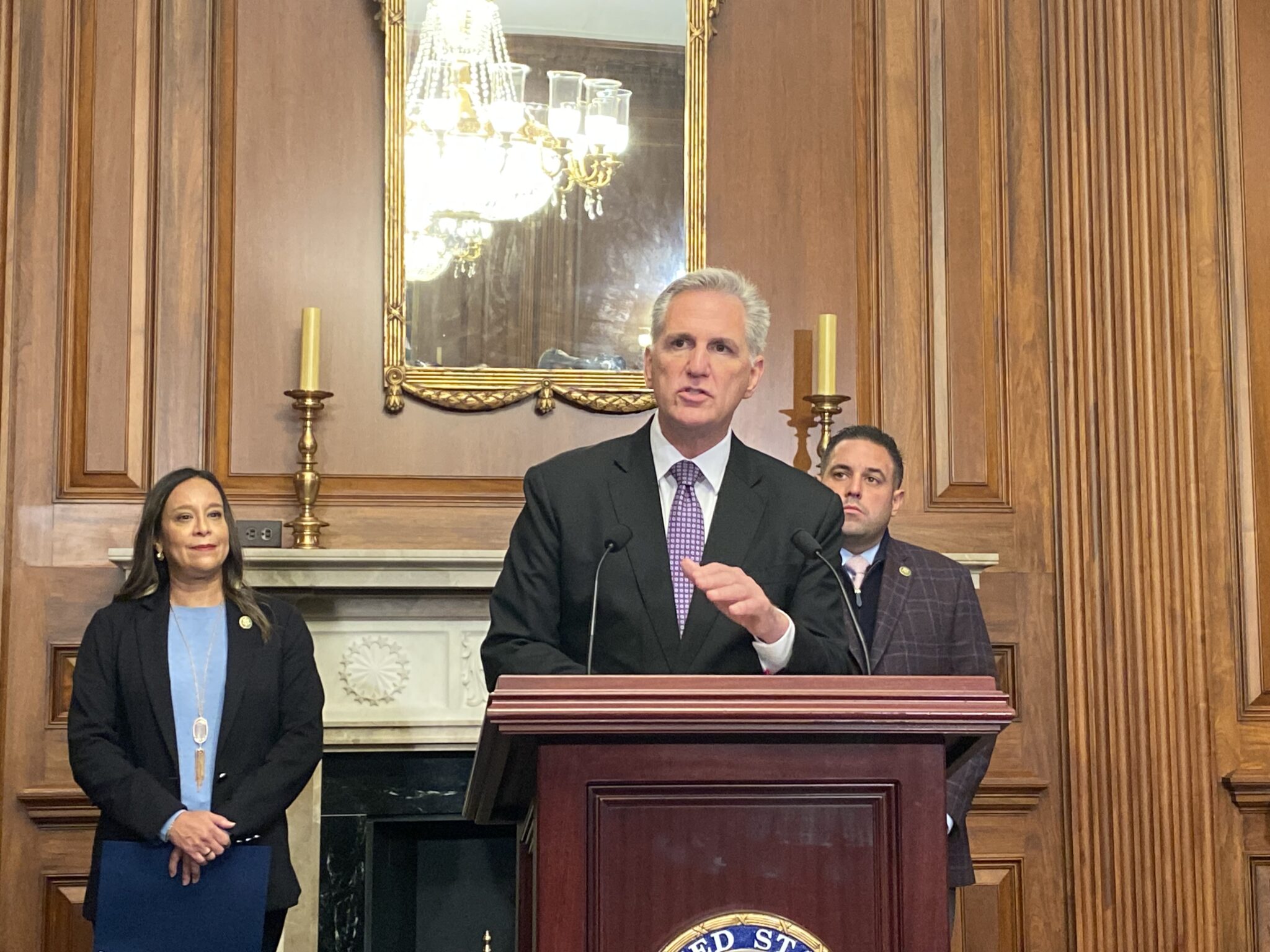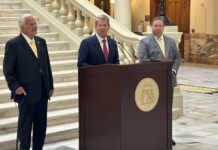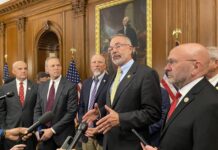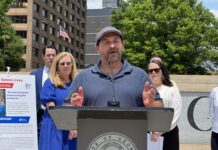
WASHINGTON (GA Recorder) — A sweeping government shutdown appeared inevitable on Friday, with the U.S. Senate stuck in a procedural holding pattern on its bipartisan stopgap bill and divided U.S. House Republicans unable to pass their short-term spending bill.
Both chambers of Congress must approve, and President Joe Biden must sign, government funding legislation before midnight on Saturday; otherwise, a funding lapse would begin on Oct. 1.
But mid-afternoon Friday, a month-long funding bill packed with steep spending cuts drafted by some of the more conservative members of the House GOP failed to pass, 198-232. Twenty-one Republican members opposed it. The measure would have had no future in the Democratic-controlled Senate.
House leaders following that vote announced they will be in session and voting on Saturday, though on what was not immediately clear ahead of a GOP conference meeting in the late afternoon.
The mood lagged in the U.S. Capitol on Friday, where workers and law enforcement chatted in the hallways and cafeterias about the prospect of working without pay.
More than 3.5 million federal employees would either work without pay or be furloughed if the government shuts down. Federal employees would receive back pay after the shutdown ends, though that provision has not extended to federal contractors in the past.
U.S. troops, roughly 1.3 million people, would be required to work without pay until the shutdown ended.
A partial government shutdown wouldn’t have broad impacts on so-called mandatory spending programs like Social Security, Medicare and Medicaid, because those accounts are not predominantly funded through the annual appropriations process.
A shutdown would have varying effects on the dozens of departments and agencies that do rely on Congress to approve new spending bills each year.
Those include the Departments of Agriculture, Commerce, Defense, Education, Energy, Health and Human Services, Homeland Security, Housing and Urban Development, Interior, Justice, Labor, State, Transportation, Treasury and Veterans Affairs. Almost all services for veterans would continue, however.
Other activities were affected as well by the looming shutdown — former President Jimmy Carter’s 99th birthday party at the Carter Center in Atlanta was moved up to Saturday instead of Sunday.
Border security and spending cuts
During debate on the failed GOP bill, Ohio Republican Rep. Jim Jordan said the legislation would fund the government, cut spending and “secure the border.” GOP lawmakers attached a border security bill they passed earlier this year to the short-term funding bill.
“Three simple, common sense things, but the most important of those three is … the border situation,” Jordan said.
Florida Democratic Rep. Debbie Wasserman Schultz said the stopgap spending bill would be a “gift basket to far-right extremists” that will “slingshot” the federal government into a shutdown.
“The gutting cuts in this bill do not continue current funding like we’ve historically done in continuing resolutions,” she said. “Instead, this so-called CR slashes cancer and Alzheimer’s research, defunds the police, undercuts allies like Israel and Ukraine.”
House Republicans’ stopgap spending bill would have cut funding below current levels, resulting in billions less available for federal departments and agencies. The Departments of Defense, Homeland Security, and Veterans Affairs would have been exempted from those cuts.
White House budget director Shalanda Young argued during a Friday briefing that Speaker Kevin McCarthy should stick to the spending deal he and the president brokered in May.
“The speaker wanted to set toplines, we set them,” Young said.
Young criticized House Republicans for not agreeing to the Senate stopgap bill that would last through Nov. 17 to give lawmakers more time to come to an agreement to pass the 12 appropriations bill into law.
“This is not hard,” Young said. “It is not meant to come back and negotiate and redo things we just agreed to do three months ago. It is to keep the government open to give congressional negotiators more time on long-term bills.”
McCarthy, a California Republican, said during a press conference before the House vote that he would likely keep trying to pass a short-term funding bill ahead of the Oct. 1 deadline.
“You have watched me time and again — have you ever known me to quit after one time if it doesn’t succeed?” McCarthy said. “I don’t stop.”
Senate working on stopgap
The Senate released a broadly bipartisan stopgap spending bill earlier this week and has since taken two procedural votes to advance the measure.
But that chamber’s rules don’t allow the Senate to vote on final passage before the Saturday midnight deadline without the consent of all 100 lawmakers.
Kentucky’s GOP Sen. Rand Paul has said he won’t allow a vote as long as the $6.1 billion in additional aid for Ukraine is in the legislation. But party leaders in the Senate aren’t seriously considering removing the Ukraine money.
And Senate Minority Leader Mitch McConnell, the senior GOP senator from Kentucky, warned against forcing a government shutdown Thursday, saying it would be “an actively harmful proposition.”
“Instead of producing any meaningful policy outcomes, it would actually take the important progress being made on a number of key issues and drag it backward,” McConnell said.
Republican senators are trying to draft an amendment to the stopgap bill that would increase spending on border security and make policy changes, a move they hope would encourage House GOP leaders to put the bill on the floor.
Senate Minority Whip John Thune, a South Dakota Republican, said Friday that everything was still “up in the air” but that he was “hopeful” senators would work out an agreement before the deadline.
“I still think there’s something that can get through here before the deadline tomorrow night,” Thune said. “What exactly it looks like, I think, is still not totally resolved.”
Indiana Republican Sen. Mike Braun said following a closed-door meeting Friday afternoon that “nothing’s really coming together” because there are “too many moving parts at this stage.”
It wasn’t clear if there would be enough GOP support for the bipartisan Senate CR to move past a procedural hurdle Saturday that requires at least 60 votes, Braun said.
“It looks like probably what’s going to have to happen is something with clarity is going to have to come out of the House,” Braun said. “And I don’t know what that would be because there was a vote that just didn’t work.”
The stalemate, he said, is at the “worst point” since he’s been a senator.
Alabama Republican Sen. Katie Britt said senators want to make sure whatever they vote on is “compatible” with their House Republican colleagues.
“So we’ll see what they come up with in the morning. In the meantime, we’re going to continue to work on these measures,” Britt said. “We want to be prepared.”
Veterans health, WIC, SNAP, parks
Among agencies, the Department of Veterans Affairs would be largely exempt from the impacts since the VA is funded in advance, a rare exception to how Congress typically handles federal funding for so-called discretionary programs, which make up about one-third of annual federal spending.
The VA says that about 15,620 of its 450,000 employees would be furloughed during a shutdown, and several of its programs would be put on hold, including the education call center or GI Bill hotline, career outreach, and permanent headstone installations at veterans’ cemeteries.
Veterans would continue receiving health care as well as education and pension benefits.
Almost 7 million people within the Special Supplemental Nutrition Program for Women, Infants, and Children, also called WIC, could lose access to the program during a partial government shutdown.
U.S. Agriculture Secretary Tom Vilsack said Monday that the “vast majority of WIC participants would see an immediate reduction and elimination of those benefits, which means the nutrition assistance that’s provided would not be available.”
Vilsack, a former Iowa governor, said that USDA has a contingency fund for WIC but that it would only last a day or two.
He added that another nutrition program, the Supplemental Nutrition Assistance Program, formerly known as Food Stamps, has enough funding to last the month of October in the event of a government shutdown. There are about 40 million low-income people who rely on SNAP.
“Now, if the shutdown were to extend longer than that, there would be some serious consequences to SNAP,” Vilsack also said on Monday.
Vilsack added that amid a partial government shutdown, it will be nearly impossible for Congress to pass a new farm bill. Every five years, lawmakers must write a sweeping farm bill to set policy and funding levels for farm, food, nutrition, and conservation programs.
This year’s farm bill is set to expire Sept. 30, but lawmakers typically finish it by the end of the year. The 2018 farm bill was signed into law in December of that year.
National Park officials would need to close off access to most of the country’s 425 parks, recreation areas, and national historic sites during a shutdown.
The IRS would continue processing certain payments, maintaining its computer networks, and printing and designing tax forms for the upcoming year. However, some taxpayer services will cease during the non-filing season. Call sites that respond to taxpayer questions will be closed during a funding lapse.
Several sources of federal aid to states will also be affected, Tim Storey, the CEO of the National Conference of State Legislatures, said in a written statement Friday.
“A shutdown creates uncertainty for states and impedes access to vital federal programs,” Storey said. “While states may not feel the immediate effects, critical state services that receive federal funding, such as (Temporary Assistance for Needy Families), disaster relief efforts, cybersecurity, and child nutrition, may be put in jeopardy if Congress does not come to an agreement quickly.”
Road projects on track
Most federal funding for highways and transit, including the daily reimbursements to state departments of transportation and transit agencies, will continue without interruption.
Those programs are funded through the Highway Trust Fund, not annual appropriations. The trust fund was reauthorized in the 2021 bipartisan infrastructure law. The law also provided five years of advanced appropriations for highway and transit spending, meaning that the workers at the U.S. Department of Transportation who process those payments can remain at work with pay through a partial shutdown.
That means federal money for construction of roads, bridges, and transit would continue to flow to state coffers.
“If it’s a highway or mass transit project everybody should be at work and fully funded and able to do all of the things on Oct. 2 that they were able to do on Sept. 29,” Jeff Davis, a senior fellow at the national transportation think tank Eno Center for Transportation, said on a Friday webinar.
Air turbulence ahead
Air travel, meanwhile, could see disruptions.
Air traffic controllers, considered essential to protect life and safety, would be required to work without pay.
Federal employees were scheduled to receive a regular paycheck Friday before a potential partial shutdown. The first paycheck they miss would be Oct. 13 if the partial shutdown is still ongoing.
If a funding lapse persists that long, the air traffic controllers could begin work slowdowns, leading to air travel delays and cancellations.
Air traffic controllers are forbidden by law from striking, but the last partial shutdown saw several call in sick rather than work without pay.
“Imagine the pressure that a controller is already under every time they take their position at work,” Transportation Secretary Pete Buttigieg said at a Sept. 27 news conference. “And then imagine the added stress of coming to that job from a household with a family that can no longer count on that paycheck.”
In addition to hurting morale in the short-term, a shutdown would ruin training programs for air traffic controllers, Buttigieg said.
“We would immediately have to stop training new air traffic controllers and furlough another 1,000 controllers who are already in the training pipeline,” he said. “The complexity of the hiring and training process means even a shutdown lasting a few days could mean we will not hit our staffing and hiring targets next year.”
Other employees that would be required to work during the partial government shutdown include those in the Transportation Security Administration under the U.S. Department of Homeland Security.
Of the nearly 61,000 TSA employees, the agency expects nearly 58,000 to continue security checks across the nation’s airports.
In addition to funding lapses for most federal programs, the authorization for the Federal Aviation Administration expires at midnight Saturday, meaning that the trust funds that operate outside the normal appropriations process could not fund operations as they do for highways.
Even a short-term funding bill without an FAA extension is in practice the same as not having a short-term bill, Davis said.
“The budget authority is not available because the underlying trust fund from which it’s drawn doesn’t exist at the moment,” he said.
Parks to shutter
Almost all National Park Service sites that they are physically able to block access to would close.
“At NPS sites across the country, gates will be locked, visitor centers will be closed, and thousands of park rangers will be furloughed,” the Interior Department, which oversees the NPS, said Friday.
States and nonprofit groups can work with the federal government to fund park operations. The governors of Arizona and Utah have said they will seek such agreements this year. But even those sites may see a disruption in access as agreements are finalized and funding is secured.
Mount Rushmore National Monument in South Dakota, for example, was closed for the first three days of the 16-day shutdown in 2013. After a blizzard, the park reopened for the last three days of the shutdown with the help of nonprofit donations and an agreement with South Dakota’s state government, Cheryl Schreier, the former Mount Rushmore superintendent, said in a Friday interview.
Park sites stayed open with a minimal workforce during the 2018-2019 shutdown. U.S. Senate Energy and Natural Resources ranking Republican John Barrasso of Wyoming called for the Interior Department to do the same this year and criticized the decision to close parks.
“The Biden administration has the ability to keep our nation’s parks open and accessible,” he said in a statement. “Instead, they’re deliberately trying to make a government shutdown as painful as possible for American families and visitors alike.”
However, the Government Accountability Office said the decision to keep parks open during the shutdown was illegal. Park advocates have said remaining open without enough workers created problems.
Visitors to Mount Rushmore during the 2018-2019 shutdown “were very confused,” Schreier said. Trash and even human waste piled up as visitors couldn’t find open bathrooms.
Law enforcement officials, not visitor services employees, comprised most of the workforce.
“It makes it difficult when you don’t have, obviously, the adequate staff,” Schreier said.
Historic, cultural sites to close
Public tours of the U.S. Capitol will cease, as the Congressional Visitor Center would close down during a funding lapse. This includes tours of the complex’s storied dome.
U.S. Capitol Police will continue to report to work to secure the complex, but they will do so without pay.
“I’ve sent my membership updates to prepare for a shutdown if it happens, which it looks like it will,” said Gus Papathanasiou, chairman of the USCP Labor Committee. “I’m hoping a shutdown doesn’t happen because, with the cost of living higher than ever, this shutdown will create an enormous hardship.”
Workers with the Architect of the Capitol, the office charged with maintaining the Capitol buildings and grounds, will continue to work in a limited capacity without pay.
USCP officers and Capitol maintenance staff will receive back pay upon the end of a shutdown.
The Smithsonian museums and the National Zoo will remain open until at least Oct. 7, even if a partial government shutdown is triggered this weekend, according to the institution’s contingency plan released Thursday.
The institution, which employs nearly 4,000 across its several locations, will continue to use fund balances from prior years until they are exhausted.
Just over 1,100 Smithsonian workers will remain on the job during the shutdown to care for animals, continue lab experiments, maintain library archives, and secure the facilities.
Student loan repayments
Federal student loan repayment officially begins Oct. 1, and regardless of a shutdown, those payments are still due.
“Even if extreme House Republicans needlessly shut down the government, loan payments will continue to be due starting this month,” a spokesperson from the Department of Education said in a statement to States Newsroom.
The Biden administration did launch a one-year on-ramp program where borrowers with federal student loans won’t be faulted for not repaying their loans. However, interest will still accrue.
Education Secretary Miguel Cardona, in a contingency plan, said the department would furlough 90% of its staff. There are about 4,000 full-time and part-time employees.
Programs that would still run because they are mandatory include Pell Grants and Federal Direct Student Loans.
Some programs that would lapse include the development and awarding of grants. The Office for Civil Rights would pause its reviews and investigations guidance and regulatory actions.
Ashley Murray contributed to this article







